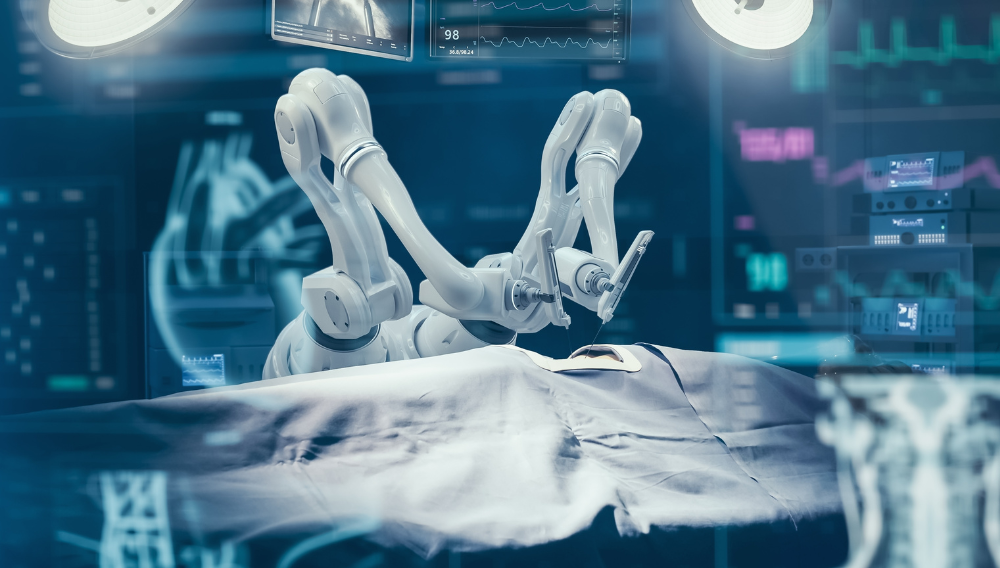5 min read
Real-Time Data Interoperability for Intelligent and Connected MedTech Systems
 Vinh Du
:
October 16, 2024
Vinh Du
:
October 16, 2024

Currently, the Medical Technology Devices industry is going through a profound transformation from traditional siloed devices to intelligent, integrated and digital ecosystems. These newer devices incorporate digital technology, sensors and connectivity to enhance precision, provide real-time feedback and improve patient outcomes.
Today, intelligent medical systems need to be able to process not only video, but also a variety of streaming data from integrated systems in real time. The expert integration of video and other surgical data can enable surgical robots and interventional systems to provide vital feedback and guidance in real time. Intelligent patient monitoring and critical care systems can even detect when a post-op patient is deteriorating and alert the care team or control other applications and devices to resolve the situation. And currently, next-generation cardiac mapping systems are integrating new technologies such as PFA that are redefining treatments for cardiac arrhythmias through controlled high energy delivery.
The sensors, controllers, algorithms and applications that make up the eyes and brain of these systems need to work synchronously to ensure safe and effective operation. Given the increasing complexity and connectivity of these systems, this is no easy task. What’s adding to that complexity is an industry-wide rise in recalls from devices that need to be re-designed to manage new failure modes, use cases and operational states, which require highly reliable, secure and resilient communications across internal and external systems.
So why is this so hard? Applications need to send and receive data to tell the controlling software what it needs to do. The data must be sent and received in a synchronized manner to ensure the applications perform their tasks correctly. Typically, the communication data type, size and data transfer rate in these systems are all unique to each system’s requirements and interfaces. This makes the task of developing networked applications in a robust and reliable manner extremely difficult. Since safety and security is of paramount importance here, the communication stack also needs to operate in a deterministic and secure manner. Therefore, it is very challenging for system designers to architect, develop and maintain a communication infrastructure that can handle all of the unique data flows and performance requirements of their applications. This is where RTI Connext can help.
DDS for Real-Time Data Interoperability
DDSTM stands for Data Distribution Service, which is a middleware communication standard defined by the Object Management Group® (OMG®). It gives applications in a distributed system the ability to communicate in a publish/subscribe and decentralized manner. Built on DDS, Connext offers MedTech device makers the advantage of RTI’s 20+ years of innovation in DDS, a well-established standard that RTI helped author. Our DDS stack has been proven in a wide variety of systems that require both real-time criticality and safe and secure communication. Connext supports a variety of host OS, target OS, CPU architecture and programming languages, enabling efficient development of interoperable and scalable reference architectures across programs and product families. Connext also offers integration with intelligent sensor processing platforms, such as NVIDIA Holoscan.

Figure 1: Application environments and operating systems that are interoperable with DDS.
As you can see from the diagram above, DDS is the common element in each platform. Therefore, all of these unique applications running on completely different operating systems and application stacks can still seamlessly communicate with each other. Connext also provides a Routing Service gateway to bridge from the DDS databus to any other networking middleware. This allows legacy systems to continue to use their existing middleware and still leverage the benefits of interoperability with Connext.
Complexity
Connext simplifies the communication interface for system designers. It has been ported to a large set of operating systems. Therefore, from the software developer’s point of view, the application logic is the same whether it is targeted at an Intel x64 processor running Windows or an Armv8 running QNX . The decoupling of function calls to the OS APIs and Quality of Service (QoS) parameters from the application logic makes the application code much more portable and much easier to maintain when unforeseen changes are required.
Another powerful feature that DDS offers application developers is the ability to not have to write their code specifically to the device interface through which they would like to send or receive data. Since DDS will discover the peers on the DDS databus, the application does not need to specifically identify the peers through which it wants to communicate.
Reliability & Performance
Connext enables applications to exchange data through a global virtual data space. This enables systems to communicate on a peer-to-peer basis, with no central brokers. The freedom this decentralized architecture provides offers both reliability and performance benefits.
For example, Connext allows you to use different transports for communication between endpoints in your application such as shared memory, UDP and TCP. This flexibility enables users to take advantage of different transports for discovery data and user data in the same application. The pendulum swings between reliability and performance in any networking application is difficult for application developers to choose – DDS helps that process by making it highly configurable With Connext, you have the flexibility to choose best-effort or reliable communication, since the reliable transport in Connext is configured at the endpoint level and on a per-Topic basis, rather than applied globally at the IP connection level.
In a publish/subscribe environment, these Topics are configured with DataReaders and DataWriters. A DataReader is an entity that subscribes to data published by the DataWriter on a specific topic. The DataReader is responsible for receiving data samples from the Connext databus and making them available to the application. The level of fine-grained reliable QoS tuning gives the application developers the option to apply reliable reliability when it is necessary and accept best-effort reliability when performance is a must. For more information on these concepts, please click here.
Flexibility
Since DDS provides dynamic discovery for all endpoints, the application isn’t assigning static IP addresses for a specific peer or set of peers in code. Instead, the DDS discovery protocol assists DDS applications in finding each other. This is generally known as location transparency. The advantage for users is that the application has the flexibility to be moved from location to location without needing a single line of code to be modified.
In addition to application portability without having to modify a single line of code, another way Connext provides flexibility is through its use of IDL (Interface Definition Language) to define the data types that will be communicated between the various DDS endpoints in the distributed system. It allows developers to specify the structure of the data, including the types of each field, in a way that can be used to generate code in various programming languages. This ensures that data can be consistently and correctly interpreted across their heterogeneous platforms.
Connext also supports IDL extensibility which is the ability to define data types that can evolve over time without breaking compatibility with existing systems. This is achieved through the use of extensibility annotations (Final, Appendable and Mutable) in IDL, specifying how a data type can be extended or modified. Therefore, a system that has already been deployed can communicate with a new system that has extended the IDL data type definition with additional fields that did not exist when the original system was created.
Cybersecurity
With Connext, network security protection is applied outside of the application logic. Therefore, DDS-Security™ is decoupled from the DDS application. The security features are implemented as plugins, which means they can be configured and applied independently of the application code. This allows security to be managed separately from the application logic, providing flexibility and ease of integration. Security is applied after the application-level API calls, but before the data reaches the network, making it independent of both the application code and the network transport protocol.
This decoupling allows for the application of tailored security policies specific to each application or data Topic without impacting the application development process, which can help save significant time and effort for development teams. The RTI Security Plugin provides fine-grained access control over communications at the Topic and endpoint level. The QoS of each application can be configured to be read only or write only or both which allows for the protection of individual data flows.

Figure 2: Data-centric cybersecurity provides the ability to design systems that restrict access control (e.g., authentication, encryption) for data in motion based on the principle of least privilege
Summary
So, coming back to the main reason why leading MedTech companies are increasingly using Connext for their communication stack, it is because next-generation systems are made up of a mix of heterogeneous hardware, operating systems and sensor devices. Connext is uniquely able to provide the software technology and comprehensive tool suite that customers need to accelerate development and simplify the complexity of these rapidly evolving systems.
For more information about how data flow is transforming connected medical devices, please click here. For more information about RTI in healthcare and medical devices, please visit this page.
About the author:
 Vinh Du is a Sr Field Applications Engineer at RTI. He has a background in Real Time Operating Systems. He has been supporting customers designing real-time embedded systems for 28 years. He holds a BA in Business Economics from the UC Santa Barbara.
Vinh Du is a Sr Field Applications Engineer at RTI. He has a background in Real Time Operating Systems. He has been supporting customers designing real-time embedded systems for 28 years. He holds a BA in Business Economics from the UC Santa Barbara.
Posts by Tag
- Developers/Engineer (180)
- Technology (79)
- Connext Suite (77)
- News & Events (75)
- 2020 (54)
- Aerospace & Defense (52)
- Standards & Consortia (51)
- Automotive (38)
- 2023 (34)
- 2022 (29)
- IIoT (27)
- 2025 (25)
- Leadership (24)
- Healthcare (23)
- 2024 (22)
- Connectivity Technology (21)
- Cybersecurity (20)
- 2021 (18)
- Culture & Careers (15)
- Military Avionics (15)
- FACE (13)
- Connext Pro (10)
- JADC2 (10)
- ROS 2 (10)
- Connext Tools (7)
- Connext Micro (6)
- Databus (6)
- Transportation (5)
- Case + Code (4)
- Connext (4)
- Connext Cert (4)
- Energy Systems (4)
- FACE Technical Standard (4)
- AI (3)
- Oil & Gas (3)
- Research (3)
- Robotics (3)
- #A&D (2)
- Connext Conference (2)
- Edge Computing (2)
- Golden Dome (2)
- MDO (2)
- MS&T (2)
- RTI Labs (2)
- TSN (2)
- ABMS (1)
- C4ISR (1)
- DOD (1)
- ISO 26262 (1)
- L3Harris (1)
- LabView (1)
- MOSA (1)
- MathWorks (1)
- National Instruments (1)
- Simulation (1)
- Tech Talks (1)
- UAM (1)
- Videos (1)
- eVTOL (1)
 Success-Plan Services
Success-Plan Services